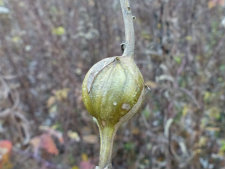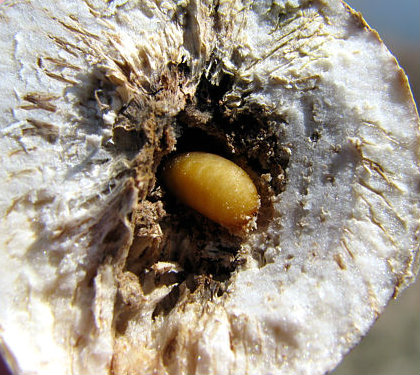*** UPDATE ***
Winter Survival Food is now available! This full colour booklet shows you how to forage for wild edibles during the lean winter months, giving your body the nutrition it needs to survive.
****************
The goldenrod gall fly lives its entire life on goldenrod plants. This fly is small and grows to be about five millimetres long with females usually being a bit larger. Females have an ‘egg-laying tube’ (ovipositor) that extends from their abdomen making them easier to identify.
Adult gall flies spend most of their time walking up and down goldenrods because they do not fly that well. The male chooses a bud and simply waits until a female arrives. When a female comes close by the male makes specific movements in hopes of attracting her. After they mate, the female locates a suitable spot on the goldenrod stem to lay her eggs; then she injects her ovipositor into the stem. Adult goldenrod flies live about two weeks.
Fly Larvae
In about ten days, the larvae will hatch and they immediately start to eat inside the stem. Larvae saliva contains a chemical in which it causes the plant to grow abnormally; this creates the gall.
Larvae will stay in the gall one year before becoming adults. They continue to eat the stem which in turn makes the gall continuously grow until it’s the size of a golf ball. As autumn approaches the plant turns brown and the larva digs an escape tunnel but will not leave the gall until spring. The larva produces a chemical in its body, a sort of anti-freeze, to help keep it from dying throughout the winter months.
In the spring each larva becomes a pupa before hatching into an adult. Interestingly, the adult goldenrod gall fly does not eat.
 Goldenrod larvae and gall flies have predators; Downy Woodpeckers and Chickadees know there is a juicy treat waiting for them in those galls and they will break them open to eat a larva. There is a beetle that will burrow into the gall to have a meal. Two species of parasitic wasps also prey on goldenrod gall fly larvae. These wasps use their own ovipositors and inject eggs into the gall. When the eggs hatch the wasp larva eats the gall fly larva.
Goldenrod larvae and gall flies have predators; Downy Woodpeckers and Chickadees know there is a juicy treat waiting for them in those galls and they will break them open to eat a larva. There is a beetle that will burrow into the gall to have a meal. Two species of parasitic wasps also prey on goldenrod gall fly larvae. These wasps use their own ovipositors and inject eggs into the gall. When the eggs hatch the wasp larva eats the gall fly larva.
Goldenrod gall flies do not seem to have any effects on us. They do not sting or bite and they tend to be focused only on mating and goldenrods; in fact, their activities do not even harm the goldenrod.




